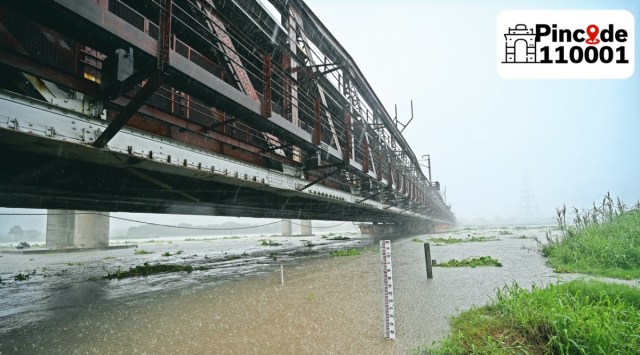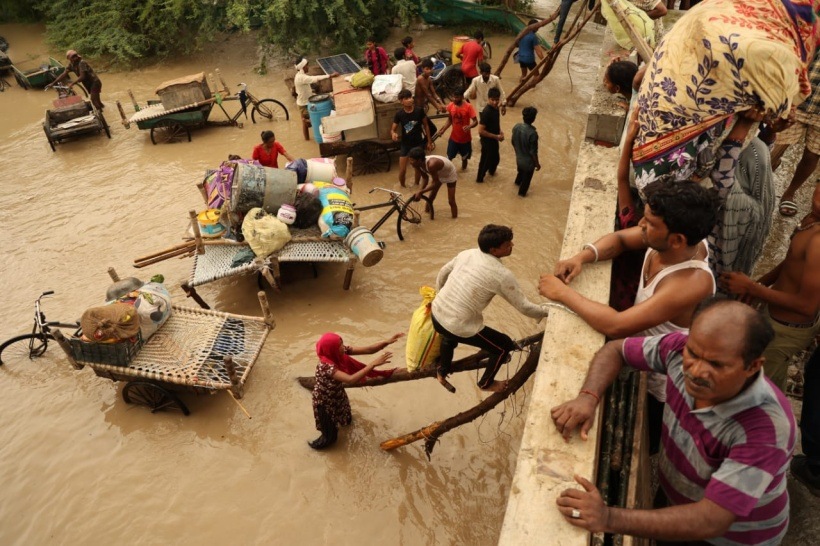Currently bearing the brunt of the rising Yamuna, the Old Yamuna Bridge, popularly known as Lohe ka pul, has seen several chapters of history unfold in the capital in its 150 years of existence.
The construction of the 12-span bridge situated near the Red Fort began under the British government in 1863 and finished in 1866. Initially, it had a single railway line which was later converted to a double line.

It has withstood many floods, the most devastating of which was in 1978 when large parts of the city were submerged as the Yamuna’s water levels rose.
Story continues below this ad
Incidentally, the construction of the structure began a year after the death of Bahadur Shah Zafar, the last Mughal emperor, who is said to have not been in favour of the East India Company’s plan for a bridge right behind the Red Fort.
According to historian Swapna Liddle, the construction of the bridge was no mean feat considering how wide the river was in the 19th Century.
She told The Indian Express: “Today, we see it (Yamuna) as a small river but historically, it is a very big river… to build a bridge like this across a huge river was technologically quite a feat.”
Before the Lohe ka Pul, also called Bridge number 249, was built, makeshift bridges fashioned out of boats were in use. “The Mughals, for instance, never built bridges spanning the full width of these rivers; they used bridges made of boats. The boats used to be tied across the banks of the river. In fact, even the British used the same bridge which used to be dismantled with the rise in Yamuna water levels during the monsoon,” she said.
Story continues below this ad
1/16

The water level of the Yamuna River in
Delhi rose to a 45-year high of 208.05 metres on Wednesday. (Express Photo by Tashi Tobgyal)
2/16

As relief measures for those evacuated from the river's floodplains are being put into place, Chief Minister
Arvind Kejriwal blamed the situation on the magnitude of water being released from the Hathnikund barrage in Haryana. (Express Photo by Tashi Tobgyal)
3/16

Schools, colleges and universities will be shut till Sunday and all govt officers, except those on essential duties, will work from home. An advisory to private companies to ask employees to work from home will also be issued soon, CM Arvind Kejriwal informed. (Express Photo by Tashi Tobgyal)
4/16

Residents from the low-lying areas of the Yamuna Pushta wade through flood waters with their belongings, cattle and pets to reach the safety of roadside shelter near Mayur Vihar in New Delhi on Wednesday. (Express Photo by Tashi Tobgyal)
5/16

People sit atop their submerged homes at Yamuna Bazar, after the water level rose above the danger mark in New Delhi. (Express Photo by Tashi Tobgyal)
6/16

Amid the flood situation in the capital, Delhi CM Arvind Kejriwal appealed to the people to not step out of their homes if not essential and resort to work from home. He also advised people to not use roads around the river as they have been inundated. (Express Photo by Tashi Tobgyal)
7/16

People wade through a submerged Monastery Budha Vihar Market after waters in the Yamuna rose to its highest recorded levels in New Delhi on Wednesday. (Express Photo by Tashi Tobgyal)
8/16

With the situation deteriorating every passing hour, Kejriwal urged the Centre to intervene, and the city police imposed Section 144 of the CrPC in flood-prone areas to prevent unlawful assembly of four or more people and public movement in groups. (Express Photo by Tashi Tobgyal)
9/16

The water level breached the previous high flood level of 207.49 m, which was recorded in 1978. According to an official of the Irrigation and Flood Control Department in Delhi, the city has records of the water level at the river at the Old Railway Bridge only from 1978. (Express Photo by Tashi Tobgyal)
10/16

A dozen NDRF teams have been deployed in Delhi to tackle the situation. Three teams each have been deployed in central, east and north east Delhi while two are stationed in south east Delhi and one in Shahdara area of the national capital, a force spokesperson said. (Express photo/Ayesha)
11/16

The national capital is staring at a drinking water shortage as the Delhi government decided to cut down supply by 25 per cent following the closure of three water treatment plants due to the rising level of the Yamuna. Seen here is flooding at ITO. (Express photo by Amit Mehra)
12/16

Seen here is a flooded road near ISBT as the swollen Yamuna river floods low-lying areas. (Express photo by Amit Mehra)
13/16

The Delhi Traffic Police issued an advisory on the restrictions and regulation of vehicular movement in place. (Express photo by Amit Mehra)
14/16

Since the rainy monsoon season began on June 1, Delhi has recorded 113% above-average rainfall, the India Meteorological Department said, and the rains in the hilly states to the north have fed the river's floodwaters. (Express photo by Amit Mehra)
15/16

Several key areas in Delhi, including the Secretariat housing the chief minister's office, were flooded, impairing normal life and traffic movement as authorities scrambled to lead rescue and relief efforts. (Express photo by Amit Mehra)
16/16

Brief spells of light rainfall occurred in parts of central and south Delhi like Lajpat Nagar, Saket, Malviya Nagar, Hauz Khas and Jangpura. (Express photo by Amit Mehra)
On the bridge’s connection with the Railways, Liddle said, “When the Railways network started to be built, the British decided they wanted to have a line over the river as well… On the last day of 1867, the first train crossed the bridge and came into Delhi.”
Construction of the bridge was overseen by George Sibley, chief engineer of the northwest province of the East Indian Railway company. “The large bridge over the Jumna at Delhi was being rapidly pushed forward when the Government of India proposed that the line should proceed to Lahore, via Meerut and Saharanpur, instead of from Delhi, in a direct line to Ferozepur,” wrote George Huddlestone, in his book History of East Indian Railway: Volume I.
A famous tale attached to the bridge, once narrated by chronicler R V Smith, is of a father-son duo who worked as bridge guards on alternate days and nights during the 1950s. In addition to their guard duties, the duo had another job — recording water levels in the Yamuna, during winter and monsoon seasons.
 The construction of the bridge near Red Fort
began under the British government in 1863 and finished in 1866. Abhinav Saha
The construction of the bridge near Red Fort
began under the British government in 1863 and finished in 1866. Abhinav Saha 



























